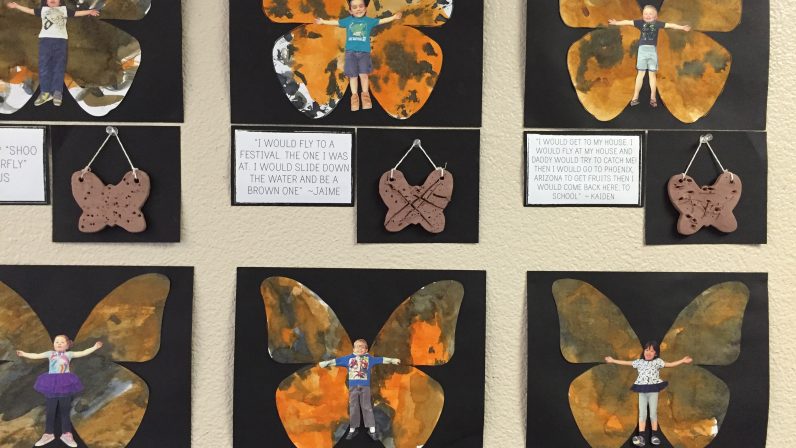Every Seed week begins with the Monday meeting. All classes, minus a toddler class or two, gather in a huge circle that fills up the multi. We begin in silence, sing to children who have birthdays that week, go over general school business, then move around the circle as each class shares what it’s planning for the coming days. It’s a mini glimpse into the student engagement in each classroom. Several classes have been studying the butterfly’s life cycle. Given that it’s spring and everyone is outside more, it’s not surprising for this to be a topic of study.
As we focused our attention on news from each class, the butterfly life cycle came up several times. When it came to the Preschool 3s, who had actually hatched butterflies from eggs as part of their emergent curriculum, the different stages were mentioned. I heard someone say something about eggs and the caterpillar. Then a small voice announced, “Then it comes out of its raccoon!” Raccoon?!! Once it registered what the child was saying, polite chuckling spread around the room. It was one of those moments I love so much when a child uses a word that is close but not exactly on the mark.
The kind of work we do with children is anything but superficial. Even very young children learn about life cycles of creatures, what a chrysalis is (aka raccoon), and how eggs transform into living creatures. The PreK class has been observing a mother dove who established her nest at the children’s eye level on a shelf outside their classroom door. They learned to be respectful of her and to practice being excellent observers. One morning she and the eggs were mysteriously gone, and they’ve spent the rest of this week wondering what happened. They are learning that sometimes things don’t work out the way we think or hope they will. These same children, who have been studying the human body, will have a chance to see a real human brain today, brought in by one of the 3rd/4th grade parents. The bird and the brain will undoubtedly make a lasting impression on these young minds. Their conversations about these topics will secure them in their growing minds.
What we do at the Seed is introduce children to the world, give them the vocabulary to describe it, then follow up on their approximations. We keep talking about those approximations, so eventually they understand the difference between a cocoon and a raccoon. They learn through conversation and questions. Ralph Peterson, my mentor and main teacher at ASU, has this to say about conversation in his book Life in a Crowded Place (p. 53-54): “When students have the opportunity to practice conversation, they learn how to attune themselves to the spirit expressed. They become sensitive to the effect their participation will have on others. They learn to disagree without commanding center stage or causing the conversation to collapse into argument. Through experience in conversation we learn how to enter into the thoughts of another person and to experience more than is expressed in the skin of speech…Conversation is central to community making.”
Learning like this is present in every Seed classroom. As children practice using their words to express themselves and understand others, they are also learning how to be in the world. It’s a part of the Seed that stays with a child long into the future. Keep your eyes open, and you’ll see.

